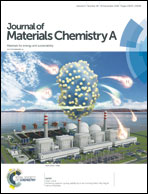Fe(CN)63− ions confined into porous pillared-carbon nanosheets for high energy density supercapacitors†
Abstract
Traditional positive electrode materials such as transition metal oxides/hydroxides/sulfides exhibit high capacitances for asymmetric supercapacitors. However, their rate performance and cycling stability are rather poor. Herein, we develop a novel strategy for the design of Fe(CN)63− ions confined into porous pillared-carbon nanosheets (F–OPPCNs) as a positive electrode material for high energy density asymmetric supercapacitors. As a result, the specific capacitance of the F–OPPCNs (363 F g−1) is about three times higher than that of pillared-porous carbon nanosheets (PPCNs, 126 F g−1) due to the existence of the additional faradaic reaction. Benefiting from the high performances of the positive electrode, the as-assembled asymmetric supercapacitor delivers a high energy density of 48 W h kg−1 at 960 W kg−1, much higher than those of previously reported asymmetric supercapacitors in neutral aqueous electrolytes, as well as excellent cycling stability with 91% capacitance retention over 10 000 cycles. Therefore, the introduction of a redox mediator into porous carbons is a versatile approach for constructing high-performance asymmetric supercapacitors.



 Please wait while we load your content...
Please wait while we load your content...